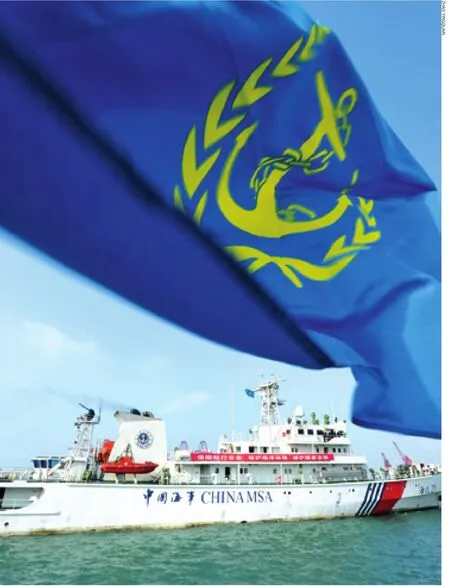ON THE DOTTED LINE LAW AND HISTORY SUPPORT CHINA'S CLAIMS OVER THE SOUTH CHINA SEA
2013-03-15TangQifang
By Tang Qifang
The U-shaped line is not a boundary line of territorial waters and is non-exclusive. It does not block other countries’ freedom of flight,navigation and laying submarine cables and pipelines granted by the UNCLOS

The author is aresearcher with the China Institute of International Studies
The Philippines decided to bring to a UN tribunal last month its maritime disputes with China in the South China Sea as well as China’s jurisdiction rights over the South China Sea within the U-shaped “nine-dotted line.” The action, however, is not conducive to the settlement of the disputes. On the contrary, it could further complicate the issue.Proceeding from the perspectives of both the historical background and international law, the recent move of the Philippines is untenable.
Historical background
In 1933, the French colonial authorities of Viet Nam seized nine Chinese islands in the South China Sea, shocking the Chinese Government of the time. No one could tell the exact location of those islands and match their Western names with their Chinese names, preventing the government from lodging diplomatic protests and claiming sovereignty promptly.Therefore, the government set up a committee to make a detailed map of South China Sea islands and confirm their Chinese and English names.
Two years later, the committee published the first map of the South China Sea area and demarcated the Xisha, Dongsha, Zhongsha and Nansha islands. Huangyan Island, which is at the center of recent tensions between China and the Philippines, was included into Chinese territory as part of the Zhongsha Islands. The map shows that the southernmost part of China’s sea border reaches 4 degrees north latitude.The South China Sea boundary line in this map is the prototype of the current U-shaped line.
After recovering Taiwan based on the Cairo Declaration and the Potsdam Proclamation following the end of World War II, the Chinese Government set about taking the Xisha and Nansha islands back. In October 1946, it sent a naval fl eet to retake the islands. Chinese soldiers erected monuments on some of the islands to assert sovereignty. The government also set up an administrative office on Taiping Island for Nansha Islands affairs. The of fi ce was under the jurisdiction of the Guangdong Provincial Government.
In the meantime, the Chinese Government strengthened its efforts on surveying and mapping the South China Sea. In 1946, Chinese experts made a survey of islands and shoals in the South China Sea. Based on the survey,China published a new list of 172 place names in the South China Sea in the following year. To spell out China’s sovereignty over the islands,the Chinese Government printed a location map of Chinese islands in the South China Sea,in which an 11-dotted line was employed in demarcating the maritime border. That line was included in the map of China’s administrative regions published in February 1948, showing China’s sovereignty over the South China Sea islands to the international community.
After the founding of the People’s Republic of China (PRC) in 1949, the 11-dotted line was also marked on the of ficial map of the PRC. In November 1953, the Chinese Government revised it to a nine-dotted line, which is still in use today. In the last six decades, official statements and legal documents have again and again reaffirmed China’s sovereignty and maritime rights over the South China Sea islands and their adjacent waters. For instance,the Chinese Government issued a declaration de fi ning its territorial waters in 1958, noting that the breadth of the territorial sea of the PRC is 12 nautical miles and that the rule applies to all the country’s territory including its mainland and coastal islands, Taiwan and its affiliated islands,the Penghu Islands, the Dongsha Islands, the Xisha Islands, the Zhongsha Islands and the Nansha Islands.
Legal basis
From a legal point of view, the U-shaped line is fully consistent with contemporary international maritime law. Its legal status is unchallengeable.
The U-shaped line, established by the Chinese Government based on international law, is legally valid. The line has been in use for more than 60 years, while the UN Convention on the Law of the Sea (UNCLOS), which the Philippines refers to as a major basis for its sovereignty claims, came into effect only in 1994.

SETTING SAIL: A vessel of the Hainan Maritime Safety Administration leaves the provincial capital of Haikou for a mission in the South China Sea on January 15
The Philippines’ sovereignty claims over South China Sea islands and their surrounding waters are untenable historically and legally.The Philippines gained independence from the United States in July 1946 with its territory de fi ned by the U.S.-Spain Treaty of Paris (1898),the U.S.-Spain Treaty of Washington (1900) and the Convention Between the United States and Great Britain (1930). The treaties state that the western limit of the Philippine territory is 118 degrees east longitude. No part of the Philippine territory lies within the U-shaped line.
The Philippines did not claim sovereignty over the South China Sea islands until the 1970s when it occupied some islets and reefs of the Nansha Islands heedless of China’s strong protests. The Philippines “legalized” its occupation through domestic legal procedures,taking the excuse of the Nansha Islands being terra nullius. Its violation of the international law is the direct cause of South China Sea territorial disputes.
The move of the Philippines to bring the disputes to a UN arbitration tribunal is unreasonable. On August 25, 2006, in accordance with Article 298 of the UNCLOS, China made it clear that it would not accept any compulsory procedure that can lead to binding decisions including the arbitration tribunal. China therefore has full grounds to ignore the Philippines’action. Moreover, the Philippine Government has no right to fi le the lawsuit. Article 298 of the UNCLOS provides that any dispute that involve the concurrent consideration of any unsettled dispute concerning sovereignty or other rights over continental or insular land territory shall be excluded from such submission. The Philippines occupied Chinese islets and reefs within the U-shaped line, raising territorial disputes between the two countries that are still ongoing. In this context, the lawsuit the Philippines laid against China is not justifiable under the UNCLOS.
Given the legitimacy of the U-shaped line and China’s sovereignty over South China Sea islands and their surrounding waters, the Philippines’ attempt to bring the territorial disputes to international arbitration will be in vain.The ultimate way to solve the South China Sea issue requires all parties to respect history, face the reality and be committed to the principles of shelving disputes and jointly developing resources in the area. ■
